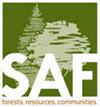Accuracy of Whitebark Pine and Limber Pine Identification by Forest Inventory and Analysis Field Crews
IF 1.5
4区 农林科学
Q2 FORESTRY
引用次数: 0
Abstract
Accurate identification of whitebark and limber pine has become increasingly important following the 2022 listing of whitebark pine as a threatened species under the Endangered Species Act. However, morphological similarities make identification of the two species difficult where ranges overlap. Using a genetic test that differentiates whitebark and limber pine, we compared field identification by Forest Inventory and Analysis field crews with genetic identification for needle samples from 371 trees. Field identifications were 100% correct for the 76 samples collected from outside regions of species’ range overlap. A total of 83% of the field identifications were correct in regions of range overlap (89% for large trees, 88% for saplings, and 78% for seedlings). Field-identified samples were correct 60% of the time for limber pine and >99% for whitebark pine. Random forests analysis revealed that identification accuracy is influenced by crew experience, large (≥ 12.7cm diameter) limber or whitebark pines recorded by field crews on the plot, elevation, Julian day of sample collection, and habitat type. We found that whitebark pine has likely been underestimated, and limber pine overestimated, within their overlapping ranges. We provide insights on improving accuracy of future monitoring where these species overlap. Study Implications: Accurate identification of whitebark pine is critical for monitoring this threatened species, yet distinguishing whitebark from limber pine can be difficult. Genetic analysis determined accuracy of field identification by Forest Inventory and Analysis (FIA) crews was 83% where the species’ ranges overlap. Virtually all individuals identified as whitebark pine were genetically confirmed to be whitebark pine, although nearly 40% of individuals identified as limber pine were actually whitebark pine. Thus, previous data underestimated whitebark and overestimated limber pine abundance in the species’ range overlap. These results quantify reliability of FIA data for whitebark pine assessments and identify areas for improvement.森林资源清查和分析外勤人员识别白皮松和林木松的准确性
2022 年,白皮松被《濒危物种法》列为濒危物种,此后,准确识别白皮松和肢松变得越来越重要。然而,形态上的相似性使得这两个物种在分布区重叠的地方很难识别。我们使用一种能区分白皮松和小叶松的基因测试,比较了森林资源调查和分析现场工作人员的实地鉴定和 371 棵树的针叶样本的基因鉴定。在物种分布重叠区域外采集的 76 份样本中,实地鉴定的正确率为 100%。在物种分布重叠区域内,共有 83% 的现场识别正确率(大树为 89%,树苗为 88%,幼苗为 78%)。野外识别样本的正确率为:林松 60%,白皮松 99%。随机森林分析表明,识别准确率受工作人员经验、野外工作人员在地块上记录的大型(直径≥ 12.7 厘米)林柏或白皮松、海拔高度、样本采集的朱利安日以及栖息地类型的影响。我们发现,在两者重叠的范围内,白皮松很可能被低估,而林木松则被高估。我们为今后在这些物种重叠的地方提高监测的准确性提供了见解。研究意义:准确识别白皮松是监测这一濒危物种的关键,然而区分白皮松和林缘松却很困难。遗传分析表明,在这两个物种分布重叠的地方,森林资源调查和分析(FIA)人员实地识别的准确率为 83%。几乎所有被鉴定为白皮松的个体都经遗传证实为白皮松,但近 40% 被鉴定为林缘松的个体实际上是白皮松。因此,以前的数据低估了白皮松的数量,而高估了在物种分布重叠区的林缘松的数量。这些结果量化了用于白皮松评估的 FIA 数据的可靠性,并确定了需要改进的领域。
本文章由计算机程序翻译,如有差异,请以英文原文为准。
求助全文
约1分钟内获得全文
求助全文
来源期刊

Forest Science
农林科学-林学
CiteScore
2.80
自引率
7.10%
发文量
45
审稿时长
3 months
期刊介绍:
Forest Science is a peer-reviewed journal publishing fundamental and applied research that explores all aspects of natural and social sciences as they apply to the function and management of the forested ecosystems of the world. Topics include silviculture, forest management, biometrics, economics, entomology & pathology, fire & fuels management, forest ecology, genetics & tree improvement, geospatial technologies, harvesting & utilization, landscape ecology, operations research, forest policy, physiology, recreation, social sciences, soils & hydrology, and wildlife management.
Forest Science is published bimonthly in February, April, June, August, October, and December.
 求助内容:
求助内容: 应助结果提醒方式:
应助结果提醒方式:


